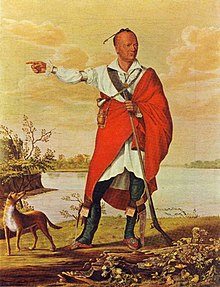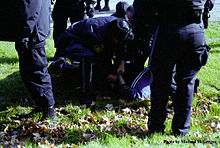Caledonia land occupation
The Caledonia land occupation or the Caledonia land dispute is a dispute between the Iroquois on the one hand and resource companies and the government of Ontario on the other, which began in 2006. The Indians refer to a donation from 1784 with which the British government gave its allies in the war against the USA a new home.
The occupation of land only became public awareness of Canada when members of the Six Nations of the Grand River occupied a piece of land on February 28, 2006, 20 km southwest of Hamilton following a demonstration. This land in Haldimand County covered around 40 hectares and was to be bought by Henco Industries Ltd. be developed as a building plot. This Haldimand Tract was promised to the occupying tribes in 1784 by the British Crown as a settlement area. The company, however, was of the assumption that they had given up the area in 1841, so that the crown was entitled to sell the land.
prehistory
During the American Revolutionary War , some Iroquois tribes supported the British, but they had to accept that their villages were burned by the American army. The British promised them a new home that would continue the traditional lifestyle. So it had to be an area that allowed hunting and fishing, corn and pumpkin cultivation , but also had enough forest to be able to build long houses.
In the Haldimand Grant of 1784, the British crown gave the six nations suitable land on the Grand River in Ontario up to its confluence with Lake Erie . Frederick Haldimand had acquired this land on May 22, 1784 to give it “forever” to the “loyal allies” of the Mohawk and any other of the six nations who wished to live there. This was done in grateful recognition of their service in the defense of the American troops. Lieutenant Governor John Graves Simcoe confirmed this act on January 14, 1793. This brought about 385,000 hectares to the six nations.
From 1795 to 1797, Chief Joseph Brant sold 381,480 acres of the northern reservation to land buyers for $ 85,332. Lieutenant Governor Simcoe was an opponent of this treaty, which should bring the tribe $ 5,119 annually. But the settlement areas were difficult to sell, so that the yield also fell.
In 1825 the Crown consulted the six nations about the construction of a road (now Highway 6) and agreed with them to lease a strip of one mile wide along the road. But in the end the agreement failed. Still, Lieutenant Governor Francis Bond Head sold the land, including the road, on. Although the government recognized in 1834 that the sales were not legal, the settlers already living there could not simply be expropriated.
As early as 1841, the six nations agreed that all land outside the reserves should be sold, but shortly afterwards they protested against it, because they had assumed that it would be leased. In 1844 they conceded that land could also be sold to build roads. Nevertheless, in 1850 an agreement was reached on a reserve of 19,000 ha.
As early as 1848, the later disputed land was sold to George Marlot Ryckman for 57 pounds and 10 shillings.
The acquisition by Henco Industries
In 1992 Henco Industries Ltd. 40 hectares of what was later named Douglas Creek Estates lands . Three years later, the tribes sued. In 2005, the division plan for the land was registered and the province of Ontario guaranteed the legal title.
The confrontation
The conflict did not ignite for the public until February 28, 2006, when the Indians erected teepees and a wooden building. Henco obtained an injunction on March 3 , which expelled the occupiers of the property. When the sheriff in charge gave the order two days later, it was demonstratively burned by Dawn Smith.
On March 17th, the responsible sheriff had to read the order aloud to the occupiers, plus a court order and threat of police violence. A second attempt on April 20 resulted in the erection of a road blockade using burning tires on Argyle Street, the main route to Caledonia . Four days later, local residents demonstrated to end the dispute. After an accident on a bypass, the occupiers opened Argyle Street on May 16, but the road was closed again after the accident site was cleared. After another accident the next day, the Caledonia Citizens Alliance requested the evacuation. On May 22nd, there was a fight between them and the Indians who had eased their blockade. Then they set up their barricades again, the Citizens Alliance also set up barricades. The police struggled to keep the demonstrators separate. The nervousness was heightened by a fire that was traced back to vandalism , which led to power outages. The state of emergency has been declared.
On April 30, the former Prime Minister David Peterson (1985–1990) was asked to help resolve the conflict. Allen McNaughton, chief of the six nations, relied on peaceful means.
There were expressions of solidarity at the Cree in Saskatchewan . They occupied the Yellowhead Highway near Battleford for two hours .
On May 23 and 24, the blockade on Argyle Street was dismantled and electricity was restored. Nevertheless, the country remained occupied and on June 5th there was a clash between occupiers and residents , i.e. non-indigenous local residents. Four days later clashes with 200 residents occurred again , but documents were released that disclosed undercover people and informants. The first arrest warrants were issued because of the considerable use of force involved in obtaining this information.
On June 12, 2006, Ontario Premier Dalton McGuinty broke off negotiations with the occupiers. However, after some barricades were cleared, negotiations continued. On June 16, the government announced that it had bought the land from Henco and would pay $ 1 million to protest victims.
Four days later, some of the squatters began an unofficial archaeological dig on the Douglas Creek site. They went public on January 16, 2007 with the result that they had found a grave site and the remains of a house.
On July 11th, the squatters cleared concrete blocks to give access to the area again. Nonetheless, on August 7th, clashes took place again, in which over 100 people took part, and nobody was probably injured.
On August 8, Superior Court Judge David Marshall ordered the Ontario government to hold off negotiations until the occupiers had left the country. But the negotiations should continue until the decision of the appellate court. On August 27th, it fended off all demands for eviction and left it up to the participants to decide to continue their negotiations.
When an action group tried to enter the premises on October 15, the approximately 400 participants were stopped by the police. Their leader, Gary McHale, was arrested on December 16 for breaking the peace.
A construction worker was seriously injured in the head during another occupation at the Stirling Woods Development , which comprises 90 houses .
Since then, the Ontario government and the six nations have been negotiating the status of the site. For the first time since 1924, the representatives of the government recognized the traditional tribal council, not the one imposed by the Indian law , as a negotiating partner. In 2014 a court ordered the removal of the blockade that had existed since 2006.
literature
- Graymont, Barbara: The Iroquois in the American Revolution , 1972, ISBN 0-8156-0083-6 .
- Taylor, Alan: The Divided Ground , 2006, ISBN 0-679-45471-3 .
See also
Web links
- Ingar Solty et al. Sam Putinja: Atone for old injustices, in: Junge Welt, May 5, 2012
- Six Nations Reclamationinfo. Under no law is theft legal
- Six Nations website
- Garry Horsnell, Six Nations Claims difficult to resolve, in: Citizens of Caledonia, April 28, 2007
- Gerd Braune: This country is our country, in: Handelsblatt, June 7, 2006
Remarks
- ↑ County votes to remove barriers at native blockade site in Caledonia , in: Toronto Sun, June 25, 2014.



